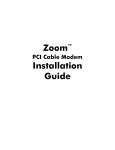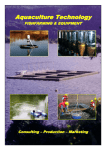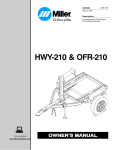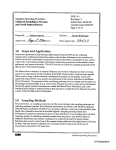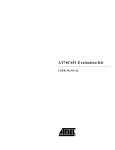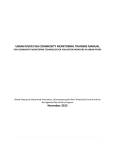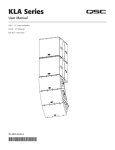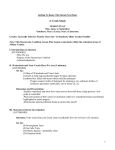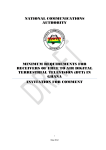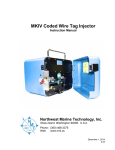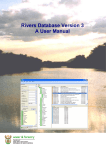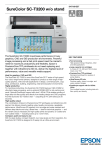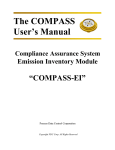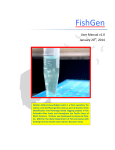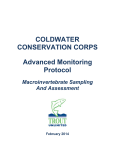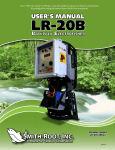Download Scientific Collection Permit
Transcript
CHAPTER 3 FRESHWATER FISH Objective The goal of fish sampling is to collect a representative sample of the species present in their relative abundances. Given the variability of habitats, flow regimes, and water chemistry, the individual biologist's judgment is important in assessing the sampling effort necessary for an adequate characterization of the fish community. However, beyond the minimum efforts outlined below, sampling will always continue until no additional species are collected despite covering new areas of the reach. Sample all available habitats and combinations of habitats. Be prepared to preserve some specimens for later identification and verification with a 10 percent formalin (one part full-strength formalin and nine parts water) solution. Scientific Collection Permit Anyone conducting fish surveys in Texas must possess or be listed on a valid TPWD Scientific Collection Permit (SCP). To apply for a SCP, contact TPWD at 512/389-4491. All TCEQ regional office and WQST staff are included on the SWQM SCP. Any TCEQ staff who need to be added to this permit should contact the central office SWQM Team. The permittee, or sub-permittees, must notify TPWD Austin main office dispatcher (512/389 4848 or 512/389-4491) or regional law enforcement office not less than 24 hours in advance of a fish collection event. The SCP number and information on who, when, and where fish will be collected are required when notifying TPWD. The TPWD requires that the original permit be carried with the permittee during collections. A sub-permittee must carry a photocopy of the original permit if the permittee is not present. If persons who will be collecting fish are not listed on a valid permit, fax a letter with the names of the unpermitted individuals and assistants participating in the collection to the TPWD dispatcher 24 hours in advance. Records In addition to sample labeling requirements as specified in this chapter, the following records must be maintained. Field logbook. For each sample event, information including the date and time of sample collection, location of the sample site (Station ID), collectors name(s), method of collection, number and type of samples collected, number of sample containers, and preservative used must be entered in the field logbook. Field notes must describe the collection methods employed, equipment used, areas sampled, the way equipment was used, time spent sampling, a description of the sampled habitat(s), and any unusual site characteristics. It is imperative that complete and accurate notes be kept on every aspect of the sampling, from effort expended for each method used to which specimens were collected and which processing procedures and preservation were used. Sample tracking logbook. A sample tracking logbook containing the information described in the QA chapter of this manual must be maintained. This logbook documents when samples arrive at the laboratory or headquarters facility, when each sample enters each sample processing step, and who has custody or responsibility for the sample. Laboratory bench sheets. Laboratory bench sheets must be maintained at the location where specimen identification and enumeration occurs. These bench sheets document the raw counts of individuals for each taxon and notes relevant to the identification and enumeration process. Freshwater Fish 3-1 06/2007 Sample Collection The method used to collect nekton samples will depend on several factors, including water body characteristics, number of sampling personnel, and available sampling equipment. The field equipment and materials necessary to collect fish are listed in Appendix A. Forms needed for biological assessments are included in Appendix C. Electronic copies of all the tables in the appendices can be furnished by Internet, E-mail, or by other means. Definitions of technical terms are located in the Glossary in Appendix F. In most streams, fish are collected using multiple gear types, such as seines and electrofishers, employed separately. Both electrofishing and seining are required for fish sample collection. If unable to employ multiple gear types, indicate the reason and increase effort with the gear employed. For instance, if seining is not possible because of an abundance of heavy debris, indicate the reason and increase electrofishing effort. It must be noted that some seining is usually possible. If electrofishing is not possible, increase seining effort. Collections at each site in the study must be comparable. Consequently, collectors must ensure that the sampling procedures, level of effort expended, and types of habitat sampled are similar in succeeding years. Once the habitat, fish, and benthic macroinvertebrate sampling crew leaders have agreed where sampling will be conducted, the habitat crew marks the ends of the reach with bright survey flagging. Sampling from areas outside those boundaries is discouraged. Electrofishing Electrofisher capabilities vary by manufacturer and model. Each model is effective under certain specific conductance ranges. For example, the Smith-Root Type 12 model is most effective at specific conductance levels less than 1,000 μS/cm, though it is rated to 1,600 μS/cm (Smith-Root, Inc. 2003). Check the manufacturer’s specifications for optimal operating procedures and consult with the manufacturer if the unit will be consistently operated at higher conductivities. A smaller ring anode may be an option in those circumstances. Alternately, the larger ring may be covered with electrician’s tape in a “candy cane” pattern. Note that battery life is shortened when electrofishers are used at higher conductivities. Collection Procedures Since the objective of the nekton sample is to obtain information on the composition and integrity of the fish community, collectors must net, identify, and enumerate all fishes possible or selectivity may occur (Murphy and Willis 1996). Backpack Electrofisher Safety. Safety is of the utmost importance. Use only commercially produced electrofishers with adequate safety devices, such as tilt switches, overload devices, and kill switches. At a minimum, two people are required when electrofishing (one to carry the backpack and the other to net fishes), though three people make an optimum crew. Caution must always be practiced while using electrofishing equipment. All participants must wear rubber linemans gloves rated for at least 1000 volts and rubber or neoprene waders. Breathable waders must not be worn as electric current can pass through them. Adjusting the backpack electrofisher. Use a backpack electrofisher in small wadeable streams, where conductivity falls within the range specified in the user manual supplied with the electrofisher. After reaching the stream, # power up the unit and set controls for ambient stream conditions, # set the initial frequency at 60 Hz at 6 ms (setting I5 on the newer Smith-Root backpacks) and the voltage at 100 volts, and # engage the unit and check the output. Since the goal is to generate the optimum duty cycle for the water conditions, disengage the electrofisher and adjust the voltage to the next setting. Power up the unit again and test the output. Repeat this procedure until the voltage is maximized (the electrofisher will automatically reset when the output is beyond specifications). In general, lower voltages are used in highFreshwater Fish 3-2 06/2007 conductivity waters and higher voltages in low-conductivity waters. Smith-Root provides general recommendations for voltage in waters of differing specific conductance—100 to 300 volts for specific conductance of 400 to 1,600 μS/cm, 400 to 700 volts for 200 to 400 μS/cm, and 800 to 1,100 volts for <200 μS/cm. Collecting. Once the controls are adjusted, reset the timer per the backpack model instructions. The collector carrying the backpack wades in an upstream direction to eliminate the effects of turbidity caused by disturbing bottom sediment. Electricity is discontinuously applied as fishes outside of the field may be herded and will not be susceptible to collection. For example, electrical current could be applied along the length of an undercut bank and then turned off until another discreet habitat type is encountered. The netters must follow and attempt to capture all stunned fishes. Wear polarized sunglasses to facilitate spotting organisms. In particularly turbid water, pull a small seine behind the electrofisher to capture stunned fishes that will be difficult to observe. Where to sample. Sample all available habitat and cover types. In contrast to routine sampling for benthic macroinvertebrates, during which only one habitat type is usually sampled, an attempt must be made to sample as many different habitat and cover types as possible. Habitats include riffles, runs, glides, pools, brush piles, undercut banks, boulders, snags, midstream bars, current breaks, and others. Actual shocking (trigger) time as recorded by the backpack timer must not be less than 900 seconds. Record time and distance on data forms. Always continue shocking as long as additional species are being collected. Note all species observed but not captured. Boat-Mounted Electrofisher Safety. As with backpack electrofishing equipment, safety is extremely important when using boat-mounted electrofisher equipment. Use only commercially produced electrofishing equipment. A minimum of three people are required when electrofishing out of a boat. Everyone on the boat must wear rubber, nonconductive gloves and knee boots or waders. Every effort should be made to keep the gloves dry. All individuals on the boat must wear personal floatation devices. The procedures for setting output is the same as for backpack electrofishers. Once the controls are adjusted, the samplers reset the timer. Electricity is then discontinuously applied. As with the backpack electrofisher, catches can usually be increased in areas of submerged cover by moving in with power on but circuit off and then energizing electrodes for an element of surprise. All habitat and cover types must be electrofished. If elevated conductivities are encountered, observe manufacturer’s recommendations about the equipment’s limits. Collecting. In larger streams, or in reservoirs and lakes, use boat-mounted electrofishers. The length of sampling effort is 900 seconds of actual shock time. When sampling in streams and rivers, boat-mounted electrofishers may be used moving either upstream or downstream depending on a variety of factors (for example: stream velocity, amount of debris in the river that one has to navigate around, turbidity, conductivity, sampling equipment). The collectors will determine if an upstream or downstream approach is be best. If the boat speed is slightly slower than the flow, it increases the chances that fishes will float to the surface and stay close enough to the boat for capture. In reservoirs, electrofishing is often most productive at night or twilight as predators move inshore to feed. One lap of the shoreline of a small lake cove is the most complete unit. Record both the distance and time of the lap. A slow, deliberate capture style is safer than fish chasing, and also yields more representative samples. If elevated conductivities are encountered, observe manufacturer’s recommendations about the equipment’s limits. Electrofisher capabilities vary by manufacturer and model. Each model is effective under certain specific conductance ranges. Check the manufacturer’s specifications for optimal operating procedures and consult with the manufacturer if the unit is consistently operated at higher conductivities. Freshwater Fish 3-3 06/2007 Seine Seining is a required collection technique in all sampling habitats. Seining is often more successful in areas where electrofishing may not be as effective, such as deep pools where wading with a backpack electrofisher would be difficult, or shallow riffles where staking out a seine and kicking the substrate efficiently captures organisms washing downstream. Seining is an active fish capture method that is used to capture mainly smaller fish and juveniles. Seines can be hard to deploy in stands of emergent vegetation or areas with a lot of woody debris, stumps, or cypress knees. Seines must be inspected for any holes and must be repaired or replaced prior to each use. In wadeable streams, use a 6 ft to 30 ft straight seine depending on stream size. One end of the seine is positioned near the bank. The seine is positioned perpendicularly from the bank. With the net fully extended (or rolled to make taut), both persons pull the net parallel to bank with person on bank slightly behind person in the channel. The person in the channel proceeds to the bank with seine extended. Both persons pull seine onto bank. Be sure the lead line remains on bottom until seine is pulled out of the water. Count and record all organisms collected by the seine or put them in a container with fixative and attach a label. Often the organisms are so small and numerous that it is preferable to bring the entire catch back to the laboratory for identification and enumeration. Repeat this process until a minimum of six replicates is collected. Collection Method Seine Types Several different seines are used, depending on the habitats. Deep pools may be sampled with a 30 ft or 15 ft by 6 ft by ¼ in mesh seine, whereas riffles, runs, and small pools are usually sampled using a 15 ft or 6 ft by 6 ft by 3/16 in mesh seine. All are straight seines constructed of delta weave mesh with double lead weights on the bottom line. Collecting. A seining crew consists of a minimum of two persons, but is more effective with three. Attempt a minimum of six effective seine hauls covering a distance of at least 60 m. It may take more than six seine hauls to cover the required minimum of 60 meters. If the seine gets caught on woody debris or the net is lifted in a manner that may allow fish to escape, the haul must be considered ineffective and not counted as viable. Capturing no fish would not necessarily constitute an ineffective haul. Keep any fish collected even if the haul is ineffective. Seining may be conducted in either an upstream or downstream direction depending on current velocity and habitat. Record the number of effective seine hauls and an estimate of the distance. As in backpack electrofishing, continue sampling until no new species are noted. Sample Preservation and Processing Field Processing Do not combine data from electrofishing and seining into one sample. The catch from each method constitutes a separate sample. Use a separate biological reporting form for each collection method. Other than voucher specimens, easily identified fishes may be counted in the field after all collection activity at a sampling location has been completed. Do not release any fishes caught using either method back into the stream until all sampling is completed! Maintain the fishes in some type of holding bucket or tank with adequate aeration. Retain two representatives of each species collected (either seining or electrofishing) for positive identification in the laboratory. Do not retain any fishes greater than 0.3 m total length. Retain all but the most readily identifiable fishes for laboratory identification. Freshwater Fish 3-4 06/2007 Use of Digital Photos as Fish Vouchers An exception to the requirement that a minimum of two representatives of each species should be retained as vouchers is to allow the use of photographs as vouchers for fish greater than 0.3 m total length. This is acceptable only when the photograph clearly shows the characters necessary for identification of the specimen to species. For fish this size, photographic vouchering is a relatively economical method which will reduce the overall volume of hazardous chemicals needed for tissue fixation and preservation and storage space needs, and will eliminate the need to obtain storage containers large enough to maintain such large specimens. Stauffer et al. (2001) provide detailed guidance for producing photographic vouchers including discussions of the following factors that they consider critical: # Choosing the right camera # Photographing specimens # Understanding the rules for capturing voucher images of fishes This document is the primary reference for the discussion of photographic vouchers. A digital camera is required to produce satisfactory photographic vouchers. When selecting a camera, Stauffer et al. (2001) identify the following camera capabilities as critical: # # # # Color photographs High pixel density CCD or CMOS Macro capability Built-in or external flash The color capability of digital cameras is expressed as color depth, which is the number of colors or shades comprising an image. The color depth is expressed as bits. A camera capable of producing 16-bit or greater digital images should be used to produce photographic vouchers (Stauffer et al. 2001) to ensure that the image adequately represents the actual coloration of the specimen. Stauffer et al. (2001) recommend that images have a minimum resolution of 1024 by 768 pixels for producing photographic vouchers. Even on large fish it may be necessary to photograph small characters such as fins, gills, spines, etc. Thus, the camera should be capable of focusing on objects that are very close to the lens. Stauffer et al. (2001) recommend that the camera be able to focus on images as close as 4 cm. It is not unusual to conduct fish assessments in low-light conditions. If possible, move specimens from shade to full sun in order to use natural light. However, in situations where it is not possible to improve natural light, the flash allows fast shutter speeds that produce crisp photos. The primary considerations for image collection and data handling are: # # # # Field of view Size referencing Identification of individuals Saving files for vouchers Fill the field of view with the specimen or the part of the anatomy being photographed. The macro option for the camera will be useful for photographing particular characters or areas of the specimen. Size is a key piece of information about the specimen and can be helpful in the identification or verification of vouchers. A means of estimating size such as a tape measure, meter stick, or some calibrated device should be included in each photograph. Freshwater Fish 3-5 06/2007 Some type of text label should be included in the image of the specimen. This might be a small dry-erase or magnetic board that includes, at minimum: # # # # # # Species Location of collection Date of collection Sample or specimen ID number Name of collector(s) Name of identifier if different from collector Cameras usually provide the capability to store images in compressed jpeg format. When selecting the degree of compression or size of the captured image, choose the physically largest image available—largest in terms of the horizontal and vertical resolution. Also, it is best to choose medium- to high-quality jpeg formats in order to preserve image quality. A name, typically consisting of a combination of alpha and/or numeric characters, is automatically assigned to an image when captured by the camera. This automatically assigned name gives no indication of the file contents. Therefore, a system should be developed to name photographic voucher images as files that can be saved and subsequently retrieved as efficiently as possible. Stauffer et al. (2001) recommend that the file name include: # # # # Species scientific name Individual identifying number Collection site description or collector’s reference code (for example: TCEQ Station ID) Date of capture This information facilitates searching files for a particular photographic voucher. For example, including the species name enables all voucher images for that species to be found on a computer by searching filenames for that species. Rules for Capturing Voucher Images of Fishes For the voucher images to convey the most information and enable identification/verification of the specimen, it is especially important that the viewing aspect is appropriate for each type of fish. By following the guidelines discussed below, Stauffer et al. (2001) suggest that most fish species can be successfully identified from digital images. Physical work done on preserved fishes is done on the right side, often damaging tissues and blemishing the specimen’s appearance. Therefore, every effort should be made to conform to the convention of photographing the left side of the fish. Also, if there are more than one species expected to co-occur, the photograph(s) should clearly show the character which allows identification of each species in the photo. Table 3-1 summarizes guidelines for the appropriate view for the photographic image of the common freshwater fish families. An assumption is made that the collector is able to use the photograph to identify a fish to family level. Table 3-1 includes families where individuals are expected to reach a minimum of 12 in total length. Freshwater Fish 3-6 06/2007 Table 3-1. Guidelines for Photographing the Appropriate View of Fish Specimens Acipenseridae (sturgeons) lateral view Amiidae (bowfin) lateral view Anguillidae (freshwater eels) lateral view Catostomidae (suckers) lateral view and ventral view of head and jaw Centrarchidae (sunfish) lateral view Clupeidae (herrings) lateral view Cyprinidae (minnows) lateral view and ventral view of head and jaw Esocidae (pikes) adults lateral view Gobiidae (gobies) lateral view Hiodontidae (mooneyes) lateral view Ictaluridae (bullhead catfishes) lateral view (clear view of dorsal and caudal fins) and ventral view of head and chin Lepisosteidae (gars) lateral view Percichthyidae(temperate bass) lateral view with anal fin flared; close-up of flared anal fin Percidae (perches) lateral view Petromyzontidae (lampreys) (adult) lateral view and view of oral disk Polyodontidae (paddlefish) lateral view Salmonidae (trouts) lateral view Sciaenidae (drums) lateral view Field Preservation The standard preservative consists of 10 percent formalin (one part full-strength formalin and nine parts water). Place specimens in this fixative while still alive, as those that die before preservation normally do not retain distinctive markings. To allow proper preservation, do not crowd fishes into bottles. Slit larger specimens on the right side of the abdominal cavity to allow proper preservation. Take care to avoid breathing, or contact with, formalin. Safety Note: Avoid breathing formalin fumes! Formalin is corrosive to the eyes, skin, and respiratory tract. Wear safety glasses and latex gloves when working with this suspected carcinogen. Always work in a well ventilated area or under a hood when preparing formalin solutions. Alcohol is highly flammable. Care must be taken in storage and handling. Check the alcohol and formalin solution material safety data sheets for proper handling requirements. Labeling a Field Sample Place in each sample container a label that includes, at minimum, the following information. Use pencil or waterproof ink on paper with a high rag content for each label. # # # # Station number and location description Date and time of collection Collection method (for example: seine or electrofishing) Preservative used Freshwater Fish 3-7 06/2007 # Name of collector(s) # Container replicate number (for example: 1 of 2 or 2 of 2), if needed Laboratory Processing Upon return to the laboratory, assign a unique sample tracking number to the jar(s) containing the fish specimens according to the sequence in the fish sample tracking logbook. For example, a system of numbering may look like F 040 04, where “F” refers to “fish,” “040” refers to sample number 40, and “04” refers to the year 2004. Identification of Fish Assemblage Samples The identification of fish assemblage samples to the species level requires taxonomic training and a familiarity with appropriate keys and literature. The validity of identifications affects the quality of community analyses and, frequently, the ALU designated for a stream. Consequently, species identifications must be performed by staff with appropriate taxonomic training. Appropriate equipment must be available for laboratory determinations of biological specimens, including a dissecting microscope, an assortment of probes, dividers, a ruler, forceps, and appropriate taxonomic references. For the purposes of identifying Texas freshwater fishes, the primary reference is Hubbs et al. (1991), with complementary sources employed as required. Sample Tracking Log When a preserved fish assemblage is brought into the laboratory, it will be assigned a sample tracking number according to the sequence in the fish sample log and logged with pertinent information, including: # # # # # # # Sample tracking number Date and time of collection Station number and location description Name of collector(s) Collection method (for example: seine or electrofishing) Preservative used Number of containers in sample Laboratory Sample Processing Keep specimens in 10 percent formalin (one part full-strength formalin and nine parts water) for at least one week and then soak in water for three days, changing the water each day. Take care to avoid breathing or exposing yourself to the formalin. Transfer to 50 percent isopropyl alcohol or 75 percent ethanol before examination. If the intent is to archive specimens in a museum, the preservative must match the individual museum’s requirements—normally non-denatured ethyl alcohol. When samples are rinsed and transferred from formalin to alcohol, take care to examine each internal label to ensure that it remains in legible condition. Labels are often destroyed during the rinsing process when samples are agitated heavily. Procedures for disposing of formalin must follow your organization’s chemical disposal plan. Complete information on curation of specimens is outlined in Fink et al. (1979). Sorting and Identification When sorting and identification begins, handle collections individually, with each staff person working up a single sample at a time. For QA purposes, maintain a record of who made the identifications. Chapter 11 provides a complete listing of required and recommended freshwater fish identification references. Place samples in a sorting tray, grouped by species. Keep specimens moist to prevent deterioration or desiccation. Again, do not combine samples collected using different methods. Once sorted and identified, place each species into a separate jar, by gear type, with appropriate labels that include the following: Freshwater Fish 3-8 06/2007 # # # # # # # # # # # Station number and location description State County River basin Name of collector(s) Collecting method (for example: seine, electrofishing) Species name (not common name) Number of specimens Range of total length Preservative used Number of containers in sample Label those that are not identifiable with a similar label noting either no species name or possibly. For example, possibly Cyprinella venusta. Affix a label to the outside of the container—but never on the lid —with the sample tracking number and container replicate number. Make sure container is dry, and wrap with clear tape to ensure the label will not come off. Laboratory Bench Sheets Prepare a laboratory bench sheet listing the species, numbers of specimens, disease presence, and sample identifiers. Sample identifiers must include information from the collecting label, such as location, date, and collector. Once species counts are completed, double check the laboratory bench sheet against the sample bottles to ensure the counts are correct. Quality Control Checks A minimum of 5 percent of all identifications are subject to a blind re-check by another biological expert. Selection of samples for re-check must be randomized. A record of re-checks must be kept for quality control (QC) purposes. If identifications done by a particular individual have an error rate of more than 10 percent, re-identify all specimens. Laboratories must be cognizant of the potential for systematic or consistent errors in identification of a particular family, genus, or species. Voucher Specimens Retain at least one representative of each fish taxon collected as a voucher specimen for a minimum of five years or until the conclusion of applicable regulatory decision (whichever is longer) to allow identification verification if necessary. Voucher specimens serve as long-term physical representations that substantiate the names applied to organisms collected as part of the TCEQ database. Voucher specimens ensure the credibility of TCEQ bioassessment data by documenting the identity of the organisms and making them available for review by the general scientific community. Take the following into consideration when storing voucher specimens: # # # # Long-term maintenance of wet (alcohol-preserved) and mounted specimens Adequate quantity and quality of space to store specimens An effective mechanism for locating and retrieving specimens upon request Personnel experience in fish taxonomy The organization maintaining voucher specimens must have a history that indicates it will be able to preserve the specimens into the future (USGS 2000). This could include in-house provisions for maintenance of samples or archiving at a natural history collection. Data Evaluation The primary tools required for analyzing fish data for wadeable, freshwater streams are described in the document Regionalization of the Index of Biotic Integrity for Texas Streams (Linam et al. 2002), as cited in the reference section. The report outlines regional IBIs and their application for assessing aquatic life uses, and provides detailed explanations of the individual metrics for the various regions. As noted in the section on large rivers, these indices may be suitable for Freshwater Fish 3-9 06/2007 evaluating fish assemblages in those water bodies as well, but that should be discussed with TCEQ staff. The full report can be found on the TPWD web site at: <www.tpwd.state.tx.us/publications/pwdpubs/media/pwd_rp_t3200_1086.pdf>. The metric sets are also found in Tables B-3 through B-9 in Appendix B of this document. Collection and Assessment Methods for Large Rivers Collecting and assessing fish assemblages in predominantly large, runoff-dominated streams and rivers present substantially greater complexity and potential problems than work in wadeable streams. The scale of the systems and corresponding fauna and habitats can be quite different. Most major drainages in Texas begin within the state or just outside its borders and drain into the Gulf of Mexico. Depending on the reach surveyed, large rivers and streams in Texas may be similar to wadeable streams in terms of discharge and scale. However, most have significant reaches that are not primarily wadeable, have substantial flow, and may pass through multiple ecoregions. Unlike smaller water bodies that are normally replicated across a given region or basin, large rivers are typically unique (Emery et al. 2003). Reference streams used for comparisons may not be available given man-induced modifications to larger waterways (for example: mainstem reservoirs, wastewater and agricultural return flows) and the lack of streams of similar size and faunal composition for comparison. Aside from issues associated with establishing a comparative baseline, large streams and rivers require different equipment or application of equipment than wadeable streams to adequately assess assemblages and may require different assessment tools. Obtaining a representative sample can be difficult given the scale and distribution of habitat patches within large rivers, making reach selection extremely important. The summer index period may not be appropriate in large rivers depending on issues such as system hydrology including seasonal releases from reservoirs, and/or irrigation withdrawals. Instead, sampling periods should be site and collection-method specific and meet the objectives of the study. Collection technologies appropriate for large rivers have varying limitations with regard to how each type of gear can thoroughly sample a single habitat or be uniformly applied to multiple habitats (Emery et al. 2003). In general, multiple collection gears must be employed to obtain a representative sample. Analytical tools for evaluating biological collections need consideration when sampling large streams and rivers. The assessment tools and regionalized IBIs described by Linam et al. (2002) are a starting point, but were designed for wadeable streams and may not be directly applicable in all situations and depend on the system being sampled. A test of the adequacy of wadeable stream sampling methods may be whether at least 50 percent of the reach can be sampled by wading methods (for example: backpack electrofisher and seines). Many reaches may be marginally wadeable, whereas others are predominately deep except for the stream margins. The former might be adequately sampled using a combination of a backpack electrofisher and seines as in the wadeable stream protocols, whereas in others boat electrofishing equipment would be more appropriate. In the latter case, seines must still be used as a complementary tool for sampling. Other gears (for example: gill nets, hoop nets) may be required depending on the objectives of the study and stream conditions. Sampling duration may vary depending upon the system scale. The USEPA has proposed 40 to 100 times the wetted stream width as a reach length to be covered when sampling in large streams and rivers. Simon and Sanders (1999) observed that 500 m was long enough to capture sufficient numbers of species to characterize biological integrity but not long enough to characterize biological diversity in great rivers. The study objectives will influence the number of reaches sampled and sampling duration. Given the aforementioned complexity in sampling and assessment, staff from the TCEQ must be Freshwater Fish 3-10 06/2007 consulted to determine the proper sampling regime and method for evaluating the samples if a study is anticipated on large, nonwadeable streams and rivers. Collection and Assessment Methods for Lakes and Reservoirs Chapter 2 discusses the index period or preferred fish-sampling conditions for lakes and reservoirs. To date, there is limited guidance on methods of assessing the biological and habitat integrity of lakes and reservoirs. The artificial nature of a reservoir can complicate regulatory processes by making it difficult to first determine what the biological community and structure must comprise for a reservoir to meet its designated ALU. The TCEQ has well developed guidance for assessing the biology and habitat in freshwater streams. There is a growing need for the same guidance in lakes and reservoirs. Development of procedures for assessing the biological and habitat integrity of lakes and reservoirs has begun (TPWD 2002), initiated by a concern that some reservoirs or portions of reservoirs were not meeting designated ALUs (based on DO concentrations). It is foreseeable that reservoirs will continue to be a concern and a uniform approach of assessing these water bodies will be an important regulatory tool. In addition to the preliminary work in Texas, a few other states and the USEPA have developed methodologies for data collection and assessment of the biological integrity of lakes or reservoirs (USEPA 1997). The Ohio EPA developed a multimetric assessment for inland lakes or reservoirs, the Ohio Lake Condition Index (Davic and DeShon 1989). The Tennessee Valley Authority developed biological assessment methods for its reservoirs that uses a similar approach to what has been developed for stream assessment (Dycus and Baker 2001). The USEPA has also published a technical guidance document for the development of lake and reservoir bioassessment and biocriteria programs (USEPA 1998). Before conducting any biological monitoring activities on a lake or reservoir, it is imperative to coordinate this work with the TCEQ and the TPWD. As methodologies and metrics are established, this manual will be updated to reflect those changes. In general, the same level of effort used per sample site for seining and electrofishing freshwater streams can be applied to sampling lakes and reservoirs. In addition to seining and electrofishing, gill netting, hook and line, and trap netting may be incorporated in the sampling effort. The TPWD has inland fishery assessment procedures specifically designed to estimate abundance and population structure for game and forage fish species (TPWD 2002). The TPWD inland fisheryassessment procedures are not designed to assess the ALU for reservoirs, but may be used as a guide for effective methods for collecting fish in reservoirs. Refer to the boat mounted electrofisher collection procedures on page 3-3 of this chapter for more detailed instructions on fish collection in lakes and reservoirs. Freshwater Fish 3-11 06/2007 Freshwater Fish 3-12 06/2007












